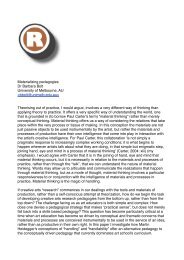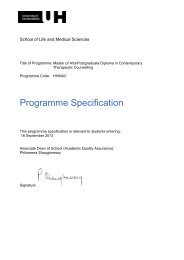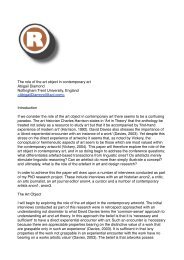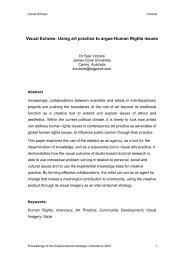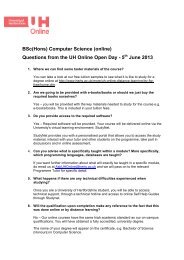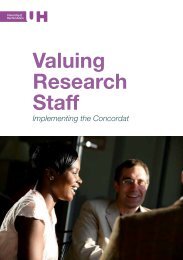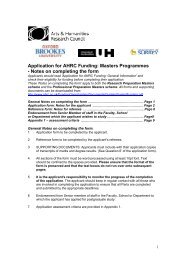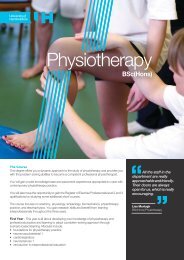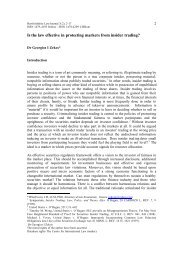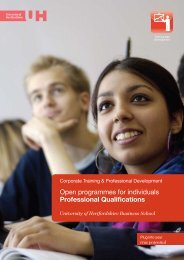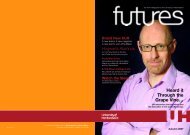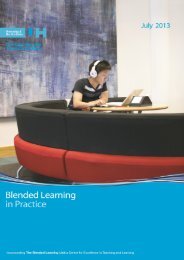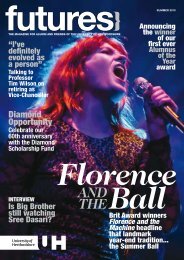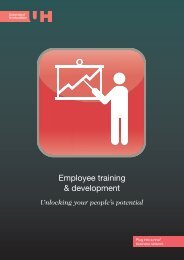June 2009 - University of Hertfordshire
June 2009 - University of Hertfordshire
June 2009 - University of Hertfordshire
Create successful ePaper yourself
Turn your PDF publications into a flip-book with our unique Google optimized e-Paper software.
Introduction <strong>of</strong> a new reflective framework...<br />
9<br />
Background to simulation learning<br />
Simulation learning is not a new idea and has been successfully used in the aviation<br />
industry and medical education for well over forty years (Abrahamson et al., 2004;<br />
Helmreich et al., 1999; Rolfe & Staples, 1986). At the <strong>University</strong> <strong>of</strong> <strong>Hertfordshire</strong>,<br />
reflective practice, already well embedded in nursing curricula since the late 1980s has<br />
subsequently become integrated into the paramedic undergraduate curriculum since 1996<br />
with the particular emphasis that contemporary paramedic practice needed to adopt such<br />
an approach beyond the traditional protocol and standard guidelines approach to<br />
emergency care management. The traditional approaches were considered to be no<br />
longer wholly adequate for meeting the diverse health care demands <strong>of</strong> the 21 st century<br />
(Jones & Cookson 2000).<br />
Since 1998 reflective practice at the <strong>University</strong> <strong>of</strong> <strong>Hertfordshire</strong> has become a major<br />
component <strong>of</strong> our experiential learning based sessions through low, intermediate and high<br />
-fidelity simulation exercises within the various undergraduate and postgraduate<br />
healthcare curricula.<br />
The word „simulation‟ <strong>of</strong>ten means different things to different people (Alinier, 2007b).<br />
Consequently, different approaches may not provide the same learning experience to<br />
students. Quinn (2000) defines simulation as being “an imitation <strong>of</strong> some facet <strong>of</strong> life,<br />
usually in some simplified form. It aims to put students in a position where they can<br />
experience some aspect <strong>of</strong> real life by becoming involved in activities that are closely<br />
related to it”. Gaba (2004) defines simulation as "a technique - not a technology - to<br />
replace or amplify real experiences with guided experiences that evoke or replicate<br />
substantial aspects <strong>of</strong> the real world in a fully interactive manner”. For purposes <strong>of</strong> our<br />
learning, teaching and research initiatives at UH we define simulation here as being 'a<br />
scenario-based clinical practice situation performed and facilitated within a safe and<br />
controlled environment using either low, intermediate, or high-fidelity approaches' in order<br />
to actively enhance the students‟ learning and clinical performance.<br />
The level <strong>of</strong> „fidelity‟ underpinning simulation is governed not only by the technology used,<br />
but predominantly by the way faculty staff actively participate, either as tutors, actors, or<br />
abstain from taking part in the simulated scenario. Scenarios may be entirely student-led,<br />
tutor-led or a combination <strong>of</strong> both ( Alinier, 2007b) with an initial emphasis on formative<br />
learning. In the context <strong>of</strong> high-fidelity simulation, scenarios are generally student-led,<br />
however educators can remotely control and modify the scenario in a dynamic way, in<br />
response to the students‟ actions and identified patient outcomes. Although clinical<br />
scenarios are usually partly predefined, they are intended to be dynamic and flexible, as<br />
their progression depends on the students' learning needs, the necessary curriculum<br />
outcomes and the interventions that must be matched appropriately to the patient<br />
simulator or actors. These can include specific clinical skills as well as inter-personal skills<br />
such as communication and teamwork. Scenarios may be conducted solely from a control<br />
room in the simulation centre or by engaging the educator directly as an actor within the<br />
scenario itself. Afterwards the educators conduct the simulation debriefing as facilitators<br />
Blended Learning In Practice <strong>June</strong> <strong>2009</strong>



